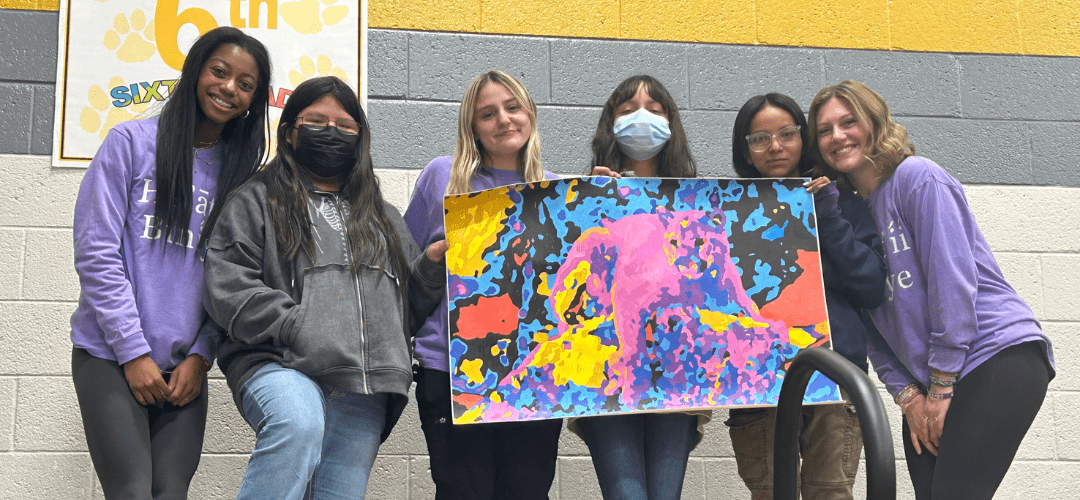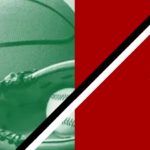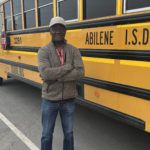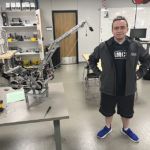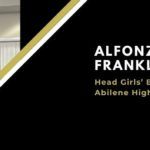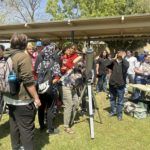This detailed travelogue memorializes each day of the Cooper Student Council’s service trip to Chinle, Arizona, in March 2024.
By LANCE FLEMING
AISD Communications
“I‘ve heard it said, that people come into our lives,
For a reason, bringing something we must learn.
And we are led to those who help us most to grow
If we let them, and we help them in return.
Well, I don’t know if I believe that’s true.
But I know I’m who I am today,
Because I knew you.”
The opening stanza to the song “For Good” from the Broadway musical Wicked.
Shortly after 12 p.m. on Wednesday, March 6, 49 students and adult sponsors loaded a bus in the Cooper High School parking lot and began a 715-mile journey to the Navajo Nation in Arizona, where we would meet people of all ages who would change each of us in different ways.
Cooper Student Council sponsor Jimmy Pogue has, for 21 years now, put together a trip to Chinle, Arizona, delivering food, animal feed, and hope to a land where life is an everyday struggle. As those of us who made our first trip to Chinle learned, life on the reservation (or, Res, as the locals call it) is hard.
But the people of Chinle welcomed us with open arms, treating us almost immediately like family. That’s because Jimmy Pogue has spent the last two decades cultivating friendships that are now like family. Chinle is his second home, and the people are like family. On the morning of Sunday, March 10, we gave away 456 boxes of food and 12 tons of animal feed to families struggling to make ends meet.
Those people were lined up in their vehicles early so they wouldn’t miss the giveaway, which began at about 7:45 a.m. We were greeted with smiles, words of thanks, some tears, and yet even more smiles. That, we learned, is the way of the Navajo people. No matter what life throws at them, we learned in our time there that the people who live in Chinle have overcome all of it in the 300-plus years the Navajo have called Chinle and Canyon de Chelly home.
I was fortunate to make the trip to Chinle this year, the first time I’ve visited the Navajo Nation. Like the other first-timers on the trip, I had no idea what to expect but was profoundly changed by the experience. I detailed each day of the journey on Facebook for friends and family back in Abilene to follow and keep up with what we were doing. What follows is each of the posts from our trip to Chinle.
WEDNESDAY, MARCH 6 (Day 1)
We piled on the bus at 12:05 pm earlier today, 48 of us armed with a boxed lunch and anticipation for what the next five days will bring. We will be back in this same parking lot at Cooper High School late Monday afternoon, exhausted and glad to be home. But I anticipate we’ll also return with our buckets filled after spending time with and serving the Navajo people in Chinle, Arizona.
This is the 21st trip that Cooper Student Council sponsor Jimmy Pogue has led to the Navajo Nation in northeast Arizona. As he told us Sunday night in our final Gathering before we left today, he’s going to see part of his family. You can’t lead this trip, work closely with the people in Chinle, get to know them, their families, and their stories, and not become family. And that’s what has happened with Jimmy and other veterans of this trip to Arizona.
Several students and sponsors have been multiple times, but those of us who have never been to Chinle are anxious to see what makes this trip unique. Questions abound:
“Will I know what to say?”
“Will I know what to do?”
“Will I feel comfortable in the environment?”
“Will I make the right impression?”
I’m sure other questions are rolling around in the heads of those who have never been. At our meeting on Sunday, March 3, Jimmy told us the question the students were most asking his counterpart and great friend in Chinle, Cammie Natay, was, “Do you think they’ll like me?”
Anticipation and a little bit of trepidation on both sides of this trip are to be expected. I believe when we meet Thursday afternoon – after a night spent in Albuquerque and another few hours on the bus – all of that will melt away, leaving only the excitement created when new friends meet and old friends reunite.
For now, we roll through the Texas Panhandle into New Mexico, sharing conversation, laughter, and budding friendships, even among our group on the bus.
Chinle awaits us tomorrow (Thursday). We are ready.
THURSDAY, MARCH 7 (Day 2)
Let me start with this: your kids were amazing today. In everything. Whether it was greeting the kids who turned out to welcome us to their school this morning, talking to and getting to know their e-pals, taking an active role in learning about the Navajo culture or making kids laugh and smile this evening at an impromptu community event in the gym at Chinle Elementary School.
Whatever it was, the kids on this trip were awesome in every way. They represented themselves, their families, Abilene ISD, and Cooper High School in an absolutely fantastic manner.
As Student Council sponsor Jimmy Pogue said to them before we ate dinner together, “You guys put a lot of smiles on a lot of faces today.”
We started the day in Albuquerque, New Mexico, with an early morning departure, wondering what would await us when we arrived in Chinle. We finish the day tired, but with our buckets full after experiencing the children, the community, the love they poured out to us, and the spirit of friendship and family that took over as soon as we stepped off the bus.
You can’t imagine what happened when our bus pulled up; you had to experience it. Children from kindergarten through 6th grade jumping up and down, waving homemade signs – many with the Cougar logo drawn on them – welcoming Cooper “home” for the 21st straight year.
When we stepped off the bus … hugs, some tears, high fives, fist bumps, more hugs, and a few more tears. Mr. Pogue has told his students for months that he was going to Chinle to see part of his family, and everyone experienced that reunion. But so did former Cooper teacher Donna Wise and her son, Will, the Cougars’ offensive coordinator, who each returned to Chinle.
Donna – who retired four years ago – was a surprise part of the trip and is in Chinle for the 19th time. Will – who made the trip as a student – is on his 13th journey to Chinle. Jimmy, Donna, and Will spent the day reminiscing with old friend and Chinle Elementary teacher Cammie Natay and her daughters, Nadia and Tristin, who have all been a huge part of each of the 21 visits by the Cooper Student Council.
The most important part of the day was the interaction with the children of Chinle Elementary, who were ready as soon as we arrived. After some initial trepidation by those from Chinle and Cooper, everyone settled into a natural rhythm and soon smiles replaced anxiousness.
The cultural exchange program in the early afternoon was educational, with seven areas arranged in the gym where elementary students were teaching high school students about different aspects of the Navajo culture.
One of the exhibits was on the traditional hairstyle.
“I didn’t expect what we saw when we got here,” Cooper sophomore Truth Burleson said. “I was a little bit scared when we got here because I hadn’t heard from my e-pal, so I didn’t really know much about her. When I met her (Nova), she said she was shy, and she spoke very softly. But once we got past the initial questions, we both noticed how much we had in common, and I could tell how excited she was to interact with us.
“The first thing she talked about was her culture and life here,” Burleson said. “She really opened up about that.”
Burleson’s takeaway on her e-pal could have come from each of the 31 students who made the almost 700-mile trip to the Navajo Nation. And the reception was also proof of what Pogue has been preaching – quite literally – to his students for the last nine months.
“I came here wanting to understand why Mr. Pogue keeps coming back, and now I do,” Burleson said. “They treated us like family and showed us nothing but love.
“He’s talked a lot about how this is family, and we saw that today,” she said. “He told us to not just drop in, but be present, experience it, and be part of it. I know we brought a lot of stuff (almost 80,000 pounds of food and animal feed), but it’s not about what we bring, it’s that Mr. Pogue and his Student Council kids have shown for 21 years that they care and want to know about the people and the culture. We prove we care because we keep coming back. And today, we were with family.”
AISD Executive Athletics Director James Garfield has a saying that he puts on most of his social media posts that reads, “Family ain’t always blood.”
Today, we saw evidence of that very thing.
FRIDAY, MARCH 8 (Day 3)
Two words. “Be Present.”
That was the message Jimmy Pogue gave his Student Council members and Chinle trip sponsors this morning as we got off the bus at Chinle Elementary School. On a day when the students gave gifts to their e-pals and engaged with the community at a dinner later in the evening, the words had nothing to do with being physically present but being present in every way.
The kids in Chinle have been looking forward to this group of Cougars making their way to the Navajo reservation as much as they’ve been looking forward to getting here. You see it on their faces – the Chinle kids and our kids – every moment. In the hallways. In the cafeteria. Everyone is smiling. Everyone is here for one thing: to live together in community.
Friday morning, before a district-wide evacuation drill at 9 a.m. that would leave the school empty for more than one hour, several of the Chinle Elementary School students joined Cooper students in learning a couple of dances: Footloose and Copperhead Road. If Thursday was Chinle students teaching Abilene kids about their culture, Friday was the opposite.
“I watched my kids dance this morning, and they don’t do that any other time,” said Chinle sixth-grader teacher Nelaine Shorty – who has been, along with Cammie Natay – the other host teacher for this visit for 21 years. “But the kids from Texas bring it out in these Navajo kids. It sets something inside the Navajo kids free, and it’s beautiful to watch. That’s the relationship piece of this visit that our kids look forward to, and I hope it is important to the kids from Cooper.”
That was the case, as evidenced by the shared smiles and laughter between children separated by a culture, sometimes a language, a race, 700 miles, and, in a sense, thousands of years of history. But each year, Shorty said, those differences melt away.
“The awesome thing about this visit is that when the Cooper kids come here, they don’t see the differences,” she said. “They only see other kids, and they embrace them and our culture, and that’s special. Many people in our community see hope in their visit each year. They’re people who are not part of Chinle who are willing to come back consistently and be part of our culture and community, even for a few days. This community has developed a trust with the school from Texas. Our community doesn’t refer to them as the kids from Cooper or even Cooper High School. They refer to them as the kids from Texas. And the community looks forward to the visit just as much as the kids on our campus. That all goes back to connectivity and real relationships.”
Shorty said “being present” every year has endeared the Texas kids to the Chinle community.
“During the pandemic, we had groups that wanted to help us, and they would come in for a short time and help,” she said. “But this (the Cooper visit) started 21 years ago, and it’s consistent and real. What the community gets out of this is knowing that this group cares about our community and culture, and they prove it by coming back year after year. We’ve had people and groups come and go over the years, but the impact of the visit from the Texas kids is long-lasting.”
The impact isn’t just on the Chinle kids, however. It’s also on the Cooper kids, which was evident Friday afternoon when the Student Council members said goodbye to their e-pals. Tears and red eyes from the Chinle and Cooper students were the order of the day as their time together ended.
It was all part of “being present.”
Pogue told his students and sponsors the pain and sadness they felt was good because “Great pain comes from great love. It’s good that you’re hurting. It means you poured into those children, and that’s what we came here to do. You have watered seeds planted by people who have been here before you, and we all get to be part of watching what comes from those seeds. I’ve had a lot of texts the last few days from people who have been here asking me to remind each of you to embrace everything about this trip.”
For one Cooper senior, that was the point of the entire day.
“I didn’t want to take anything for granted, especially today,” Noelle Mathis said. “It was important that we all enjoy our time with our e-pals and the other students and not miss the blessing of being light in their lives and letting them be light in our lives.”
Mathis is on her second trip to Chinle, and her connection to the community has only increased.
“We’re here for much bigger purposes than e-pals or giving out food on Sunday,” she said. “We’re here to be part of something bigger than ourselves; we’re here to be part of this community and love on the people of Chinle. God’s hand is clearly in this, and it’s something we don’t want to miss.”
In two days, our time in Chinle will end, and we’ll leave this place that offers a slower pace, a clean breath of fresh air, and the bluest sky you’ll ever see. It’s impact on each of us will be
“Mr. Pogue always says this place is like home,” Mathis said, “and that always gets me. When we left here last year, I left a piece of my heart here. Everything that has happened the last two days has brought those memories back, and I know when we leave on Sunday that a piece of my heart will remain here forever.”
That goes for all of us. Forever present.
SATURDAY, MARCH 9 (Day 4)
“Tell them that my one piece of advice is to look up at the sky while they’re there. As you once taught me, it’s the bluest sky you’ll ever see.”
Those words were the ones Katie Pogue texted her dad, Jimmy Pogue, just before the 48 of us left Abilene for Chinle and this trip to the Navajo Reservation that can accurately be described in many ways, but one in particular: peaceful.
For the last two days, we’ve seen the beauty of the people of Chinle. We’ve experienced community, family, love, and peace that go with living on the Navajo Reservation.
When we arrived on Thursday, it was cloudy and cool, with no blue sky above us. The sun broke through Friday, and with a partly cloudy sky, we could see a little bit of the sky that Katie — a former Student Council president who has been to Chinle nine times — texted her dad about.
But as we toured Canyon de Chelly on the outskirts of Chinle, we saw it in all of its glory. A cloudless, deep blue sky that, as Jimmy said Saturday night at our end-of-day Gathering, “will only be topped by what we see in heaven.”
On the day before we do what we came here to do (we have more than 300 boxes of food and 12 tons of livestock feed ready to be distributed tomorrow starting at 9 a.m. Abilene time), we had a few hours to just … breathe. To rest. And take in the beauty of God’s handiwork in this beautiful piece of land in the northeast corner of Arizona.
Res life is not easy. With an average household income of less than $60,000, more than 43 percent of the population lives below the poverty level. Diabetes and related health issues are a problem, as are drugs like heroin, meth, and fentanyl. It’s a hard life.
But the people we have encountered this week have been joyful, peaceful, welcoming, gracious, and proud of their heritage and culture. So today, we all had the opportunity to learn more about the culture. And what makes the people of Chinle special.
And we had the chance to gaze up into a cloudless sky at the bluest blue these eyes have ever seen.
It came early in our tour of Canyon de Chelly, the lifeblood and focus of this part of the Reservation. For nearly 5,000 years, people have lived in the canyon, which is longer than anyone has lived uninterrupted anywhere on the Colorado Plateau. Today, Dine’ families (Navajo families) make their homes, raise livestock, and farm the lands in the canyon.
The canyon walls tell the story of a people forced out of their homes by Kit Carson and the Union Army in 1864. The hieroglyphics and ancient ruins preserve the architecture, artifacts, and imagery of the different peoples who have called the canyon home: the Archaic people (2500-200 B.C.), the Basketmakers (200 B.C.-A.D. 750), the Pueblo (750-1300), the Hopi (1300-1600s), and the Navajo (1700-present).
It’s still the home to many who live in this area, and the canyon is part of the history of Chinle, which means “flowing out” and refers to the location where the water flows out of the canyon.
And it’s where I snapped a photo of a sky so blue that, for a moment, it took my breath away. As our tour guide was talking, I just stared at it. The sky was mesmerizing. It was so quiet and peaceful as we stood there, like a peace I’ve never felt.
The canyon held many other beautiful secrets: ancient ruins in canyon walls where people once lived. Artwork created by water and wind on the walls of the canyon and its rocks, including a walking man, an owl, and an alligator look-alike that nature carved into the side of a huge boulder.
As many of your children said Saturday evening, the canyon and the blue sky above it offered peace.
But the canyon also holds other stories, those of the grief and pain inflicted on an entire people simply for inhabiting the land. In January 1864, Carson – a fur trapper, wilderness guide, Indian agent, and U.S. Army officer – launched his assault on the Navajo population and Canyon de Chelly (pronounced de-Shay), destroying everything in his path, essentially eradicating the Navajo way of life.
Hogans – the traditional home of the Navajo people – were burned to the ground, livestock killed, and crops destroyed. Navajos who surrendered were taken to Fort Canby, and those who resisted were murdered. Some Navajos escaped Carson’s campaign but were soon forced to surrender because they were starving in the freezing winter months.
Skirmishes and confrontations between the Navajo and Carson’s troops — on the very land where we stood Saturday — led to the largest tribal surrender in American history. After a month of conflict, Carson and his armies initiated the “Long Walk of the Navajo,” a 300-mile journey from their homeland to internment camps at Bosque Redondo in New Mexico.
At least 200 people died during the 18-day forced march, which remains the defining moment in the history of the Navajo Nation. The Navajo were allowed to return to Canyon de Chelly a few years later with The Navajo Treaty of 1868, one of the few instances where the U.S. government permitted a tribe to return to their traditional boundaries.
Over time, the canyon the Navajo were forced to abandon has again become their home and part of the culture. But the scars – even 160 years later – remain in the canyon and the people who live here.
“The canyon is the source of the determination of the Navajo people,” said Cammie Natay, who has hosted the Cooper Student Council trip to Chinle for the last 20 years. “The people who live here know what happened in that canyon. People who take the tour into the canyon come back and say, ‘I heard the screams of the people.’
“Kit Carson brought his people through here and cleaned it out … for nothing,” Natay said. “They chopped down fruit trees, slaughtered sheep, and herded the people out of there like they were animals. And for some people to have survived that and returned to their home … if that doesn’t speak to the strength and determination of the Navajo people, I don’t know what does.”
That strength and determination are evident, even though many in this community struggle with daily necessities. Many homes in the area don’t have electricity or running water. Some have dirt floors. Others have an entire family living in one room.
But the grit and determination passed down from a generation forced to leave behind everything they owned only to be able to return home three years later is still telling the story of this majestic place.
The Navajo have a blessing they recite as the closing prayer at Navajo Way Blessing Ceremonies, and it’s called “Walking in Beauty.” The first stanza of the poem reads:
In beauty I walk
With beauty before me I walk
With beauty behind me I walk
With beauty above me I walk
With beauty around me I walk
It has become beauty again.
Your children have walked in beauty this week. And today, in that canyon marked by peace and pain, they walked in it again. It was in front of them and behind them. It was around them.
And it was most definitely above them.
SUNDAY, MARCH 10 (Day 5)
“We are asking you to give everything you have. Everything. Every bit of personality that you have. Every bit of encouragement that you have. Every bit of love that you have. We’re asking you to give every bit of everything you have on this concrete today.”
Our group arrived at Chinle Elementary School at about 7:10 a.m., and Jimmy Pogue spoke the words above to the 31 students and 16 other sponsors a few minutes later in preparation for the job we came here to do: to say thank you to the people of Chinle for opening their community, their school, their lives, and their hearts to us for the last four days.
When we pulled into the parking lot, at least 15 cars were lined up to receive some of the food and animal feed that had been donated to the Student Council. We started the giveaway at 8 am, and by 11:45, we were completely out of everything.
Out of food.
Out of children’s books.
And out of animal feed.
We handed out 456 boxes and bags of food and 12 tons of feed designated for cattle, horses, chickens, sheep, and goats. We had emptied everything we brought in an 18-wheel tractor-trailer.
We received endless smiles from the people on the receiving end of our way of saying thank you to Chinle. We were blessed with so many saying, “God bless,” “Be safe going home,” or “Thank you for coming.”
If the Sunday morning experience made life a little easier for the people on the Navajo reservation, it could be categorized as a spiritual experience for those helping distribute the trailer’s contents.
As we met Saturday night for our Gathering meeting, Jimmy challenged everyone with this: “Don’t be overwhelmed tomorrow. Look at it as saying thank you to them for what we’ve learned. They have opened themselves up and welcomed all of us into their homes, and we are saying thank you to them for that.”
The challenge wasn’t too big for your children. They weren’t overwhelmed. They said thank you to the people of Chinle in the way they had planned since they left Chinle and returned to Abilene this time last year: by emptying their bucket and giving everything they had.
As we walked to the bus this morning, I talked to Jimmy about this place and this trip and how good it’s been to have spent time in Chinle.
The pace of life here. The community we’ve experienced. The love and friendship that’s been shared have made this a place of healing, and that’s been the prescription for each of our souls.
We are headed to Albuquerque now and Abilene on Monday, tired from the hard work that’s taken place since we arrived in Chinle last Thursday. We are exhausted from the long days and early morning wake-up calls.
But we are invigorated by new and renewed friendships. Our buckets are full because of all we’ve experienced and all we have given.
And we are at peace. Healed in mind, body, and spirit.
“Who can say if I’ve been changed for the better?
I do believe I have been changed for the better.
And because I knew you. I have been changed for good.”
The closing chorus to the song “For Good” from the Broadway musical Wicked.

